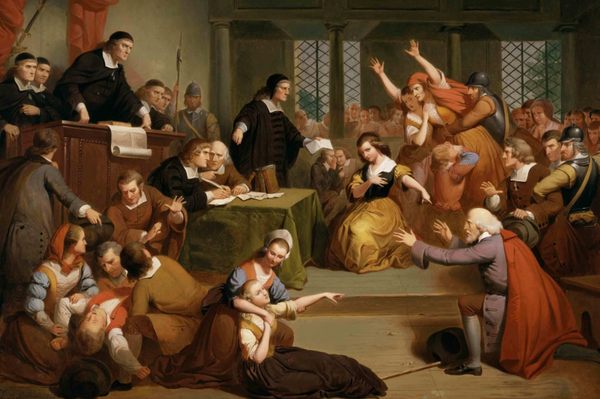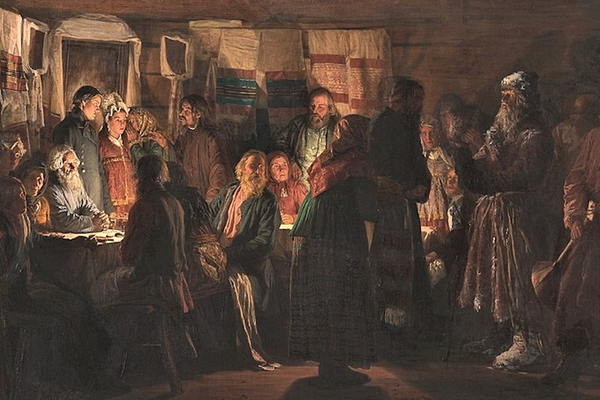On Wyoming’s Casper Mountain, the Crimson Dawn Witches Appear Every Midsummer’s Eve
Nearly a century ago, writer and artist Neal Forsling’s magical tales began a local legacy that celebrates family, nature, and imagination.
It was 1929 when Neal Forsling began telling stories of the witches who live on the mountain, revealing themselves only on Midsummer’s Eve. The writer and artist had just moved to a remote one-room cabin on Wyoming’s Casper Mountain with her two young daughters, Jean and Mary. Set high near a red sandstone butte that overlooks the valley, the 640-acre homestead, surrounded by aspen and pine forest, was a new beginning for the family of three in the wake of a difficult time.
Unable to bring most of the family’s books, Forsling used her own imagination to entertain her girls, who were 11 and 9 at the time. She was inspired during an early morning walk by the deep red color of the sandstone, and came up with the idea of a world called Crimson Dawn. From that moment, the tales flowed: There was the Cardinal Witch, who lived in a crystal cavern beneath Red Butte along with her sister, the Topaz Witch. They were joined by the Star Witch, the Black Witch, the Lavender Witch, the Emerald Witch, and Undine, the Homesick Sea Witch. Forsling added other characters, including the Phantom Woodchopper, Blind Minstrel, and Moon Maiden, as well as a leprechaun and three elves. Soon, the young mother of two had built an entire fantasy world around “a story about seven witches that she kind of pulled out of a hat,” says historian Rebecca Hunt, who is currently writing a book about Forsling.
These fictional, friendly residents of the mountain were active only on Midsummer’s Eve. On that short June night in 1929, Forsling’s first audience was small, just her daughters and two of their friends. After the tale-telling, a bonfire, and a walk through the woods, the party commemorated the event by building small shrines, scattered across the homestead’s hundreds of acres, for the different characters. None of those present at that first small gathering—“It was very informal,” says Hunt—could have imagined what the tradition would become: a large community celebration of family, summer, and the best kind of magic.

In June 1930, Forsling invited a few more friends for the Midsummer’s Eve storytelling. In the years that followed, word of mouth brought more locals, and Forsling began dressing up as one of the witches to lead the traditional forest walk. Now, nearly a century after the Cardinal Witch and friends first came to life, the annual Crimson Dawn Midsummer’s Eve celebration attracts more than a thousand people from the Casper community and beyond.
“We have a lot of people that come [year after year], some of whom are grandparents and great-grandparents bringing the younger generation,” says Hunt, who has been attending Midsummer’s Eve at Casper Mountain since she was 10 months old.
When Forsling donated her homestead property to Natrona County in 1973, it was with the condition that the community maintain the land and continue the annual event—or the property would revert to her descendants. An avid conservationist, she wanted to preserve the land, now the Crimson Dawn Park & Museum, from development.
“There’s a lot of politicians who would like to … slap a little cabin village or something on the butte. And they know the answer: If you do that you lose the land,” says Hunt, who is also director of the Crimson Dawn Association, a nonprofit that maintains park and museum, and organizes the annual Midsummer’s Eve event.
So far, the county has upheld its end of the bargain. On June 21 each year, the whimsical characters return to Casper Mountain to share their stories. Volunteers dressed as cheerful witches and friendly forest folk hand out flowers and bedeck the small, homespun shrines of gathered stones and wood scraps with more of the fresh blooms. A trail leads visitors past several of the shrines as the stories unfurl into the night. After leading the walk as chief storyteller for several years, Forsling passed the tradition to her daughters Jean and then Mary. “I started walking with Mary on the trail because she was getting older. After a number of years, she asked me if I wanted to take over,” says Hunt, who stepped into the role in 1991.
Forsling took inspiration from a variety of ancient, nature-centered pagan cultures and Europe’s Midsummer’s Eve traditions, where bonfires performed on summer solstice are said to help ward off evil spirits. While the Casper Mountain witches are more friendly than frightening, they can have a mischievous streak, says Hunt.
And while the tales were primarily made up by Forsling to entertain her daughters, they were also perhaps an escape for her. Before relocating to the cabin on Casper Mountain, Forsling and her daughters lived in downtown Casper with her first husband. There were allegations of abuse, and the couple eventually divorced. Forsling, who was born Elizabeth Paxton but preferred to go by a pseudonym she created from her parents’ middle names, wanted a safe place to raise her children, and the mountains appealed to the lifelong nature lover.

In 1930, she remarried, but her second husband, Jim Forsling, died tragically in 1942 while getting supplies during a harsh winter storm. That was the last winter that the family stayed at the cabin. From then on, they lived in town in the cold months, only spending summers on the mountain, where Forsling continued to host the annual Midsummer’s Eve event. And the celebration continued to grow. Many of the volunteers and other community members have participated for decades, such as Dyann Durst, who has portrayed the Lavender Witch since 1996 with unflagging enthusiasm, even though says she fell into the role almost by accident. “Someone had recommended me because I have green eyes and red hair, like the character,” says the lifelong Casper resident. “Being one of the witches is a very popular thing here; it’s definitely coveted.”
Forsling, who didn’t write down her stories until the 1960s, passed away in 1977. Her collection of tales was published posthumously in 1980 as Crimson Dawn: The Story of the Casper Mountain Witches. Decades later, her legacy remains as vivid in the Casper community as the colorful scenes she painted from those stories. The artwork now adorns the walls of her old cabin, still standing on the land forever linked to her friendly witches, their Midsummer antics, and flower-strewn shrines.
Now ready to retire from the storyteller role herself, Hunt is currently training an apprentice to take over the role. “This all began because Neal wanted to do something special for her kids,” says Hunt. “And she truly built a magical place.”































Follow us on Twitter to get the latest on the world's hidden wonders.
Like us on Facebook to get the latest on the world's hidden wonders.
Follow us on Twitter Like us on Facebook